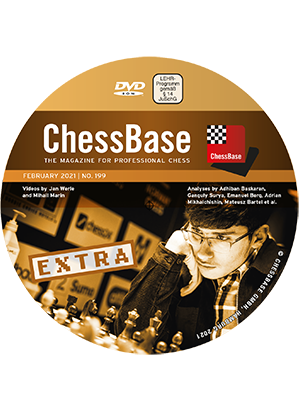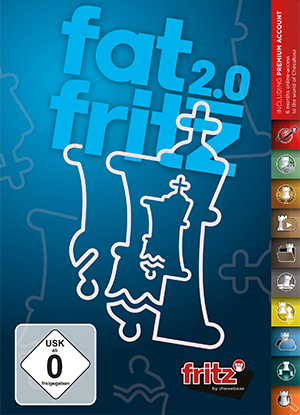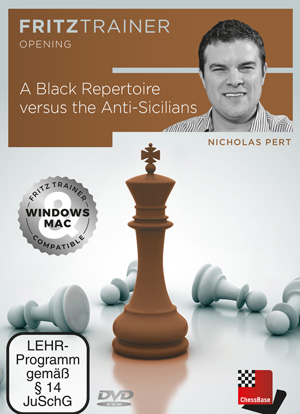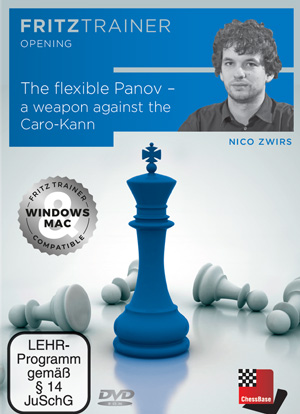CHESSBOOK REVIEWS

Latest book
reviews of 1 March 2021
Wilhelminalaan 33
7261 BP RUURLO
The Netherlands.
John
Elburg

ChessBase Magazine issue 199
Extra
February 2021
ChessBase
http://www.chessbase.com
E-Mail
info@chessbase.com
ISSN 1432-8992
Euro 12,99
System requirements:
Minimum: Pentium III 1 GHz, 1 GB RAM, Windows Vista, XP
(Service Pack 3), DirectX9 graphic card with 256 MB RAM, DVD-ROM drive,
Windows Media Player 9, ChessBase 12/Fritz 13 or included Reader and
internet connection for program activation. Recommended: PC Intel Core
i7, 2.8 GHz, 4 GB RAM, Windows 8.1 or Windows 10, DirectX10 graphic
card (or compatible) with 512 MB RAM or better, 10
The smashing
opening video’s on this DVD are from Jan Werle,with an latest trend in
the Sämisch of the King’s Indian,1.d4 Nf6 2.c4 g6 3.f3 c5 4.d5 Bg7
5.e4 d6 6.Nc3 0-0 7.Nge2 e6 8.Ng3 exd5 9.cxd5,and Mihail Marin,On the
Ruy Lopez with 6.d3,1.e4 e5 2.Nf3 Nc6 3.Bb5 a6 4.Ba4 Nf6 5.0-0 Be7 6.d3
b5 7.Bb3 d6 8.a4 Bd7 9.c3 Na5 10.Ba2 and not to forget the highly
instructive Brilliancy contribution!
The main file of this DVD,{data collect} holds 44506 entries and are
all played between 21.10.2020 and 26.12.2020.
Very good are the included 39 lucky bad game which are all more than
excellent analysed.
A fine example of play is: Vallejo Pons,Francisco (2694) -
Durarbayli,Vasif (2617) [C10]
Grand Swiss (3), 12.10.2019
[Durarbayli,Vasif]
1.e4 e6 2.d4 d5 3.Nc3 Nf6 4.Bg5 dxe4 5.Nxe4 Nbd7 6.Nxf6+ Nxf6 7.Nf3 h6
8.Be3 Nd5 9.Bd2 c5 10.Bb5+ Bd7 11.Qe2!? This is not the most principal
approach. However, it is not as harmless as I thought. Trading queens
and bishops doesn't make the game for Black easy. Black should respond
dynamically. [11.Bxd7+ Qxd7 12.c4 Nb6 13.Rc1 Be7 14.dxc5 Bxc5 15.b4 Be7
16.c5 Nd5 17.Ne5 Qc7 18.Qa4+ Kf8 19.Nc4 h5 20.0-0 h4 21.h3 Rh5 22.Rfd1
a6 23.Qb3 Rd8÷ Naiditsch,A (2686)-Vitiugov,N (2707) Poikovsky
2010] 11...Bxb5 [11...cxd4!N 12.Ne5 (12.Bxd7+ Qxd7 13.Nxd4 (13.Ne5 Qc7
14.Qb5+ Kd8 15.Nf3 (15.Ba5 b6 16.Nc6+ Kc8-+) 15...Bc5 16.0-0
Ke7µ) 13...Be7=) 12...Nf6 13.0-0-0 (13.Nxd7 Nxd7 14.Qe4 a6!
15.Ba4 b5 16.Bb3 Bc5³) 13...a6 (13...Rc8?? 14.Be3!+-; 13...Bd6?
14.Nxd7 Nxd7 15.Bc3 a6 16.Bxd7+ Qxd7 17.Rxd4±) 14.Bxd7+ Nxd7
15.Bf4 (15.Rhe1 Nxe5 16.Qxe5 Qd6 17.Bf4 (17.Qe4 0-0-0) 17...Qxe5
18.Bxe5 0-0-0 19.Bxd4 Rg8=) 15...Nf6 (15...Bc5? 16.Nxd7 Qxd7 17.Qe5 Qd5
18.Qxd5! (18.Qxg7?! 0-0-0 19.Qe5 (19.Qxf7?? Rd7 20.Qf6 Rf8 21.Qe5
Bd6-+) 19...Bd6 20.Qxd4 Bxf4+ 21.Qxf4 Qxa2=) 18...exd5 19.Be5 f6
(19...0-0-0? 20.Bxg7 Rhg8 21.Bf6 (21.Bxh6 Rxg2=) 21...Rde8 (21...Rd6
22.Be7) 22.g3 Re2 23.Rhf1±) 20.Bxd4 Rc8 (20...Bxd4? 21.Rxd4
0-0-0 22.Rhd1 Rhe8 23.Rxd5 Rxd5 24.Rxd5 Re2 25.Rd2 Re1+ 26.Rd1 Re2
27.Rf1±) 21.Bxc5 Rxc5 22.b4 Rc4 23.Rxd5±) 16.Qc4 Be7
(16...Bd6 17.Qxd4 Nd5 18.Kb1 0-0 19.Bxh6 gxh6 20.c4÷) 17.Rxd4
Qb6 Solid approach. (17...Nd5 18.Qb3 0-0 19.c4 Qc7 20.Bg3 b5÷)
18.Qa4+ Qb5 19.Qxb5+ axb5 20.Kb1 Nd5 21.Bd2 0-0=] 12.Qxb5+ Qd7 13.Qxd7+
Kxd7 14.c4 Nf6 [14...Nb6 I don't believe in this move because the
knight does not have ay good square to go from b6. 15.b3 cxd4 16.0-0-0
Bc5 17.Be3 Ke7 18.Nxd4² 1-0 (27) Naiditsch,A (2663) -Degraeve,J
(2548) Germany 2007] 15.0-0-0 [15.Ne5+ Ke8 16.Be3 (16.Bc3 Ne4=)
16...Bd6 17.0-0-0 Ke7 18.f4 Rac8 (18...cxd4 19.Bxd4 Rhc8 20.Kb1 Ne4
21.Rhe1 f5=) 19.dxc5 Bxc5 20.Bxc5+ Rxc5=] 15...cxd4 [15...Rc8? 16.dxc5
Bxc5 17.Bxh6++-] 16.Nxd4 Rc8 17.b3 Ba3+ [17...Bc5 18.Rhe1! (18.Be3 Ke7
19.Rhe1 g6=) 18...Ke7 19.Bc3 Rhd8 20.Kc2 transposes to similar
positions as in the game.] 18.Kc2 Ke7 [18...Ne4! 19.Be1 Ke7 20.f3 Nd6 I
think the knight's position on d6 is better because it stops Nf5 or Nb5
ideas, White's task hard. Nonetheless, I prefer White.] 19.Rhe1 Rhd8
20.Ba5! Forces Blacks to make a critical decision. 20...Rd5?! I didn't
desire to wait passively for my opponent to break my defense. On the
other hand, Rd5 wasn't the right strategy. The position didn't allow me
to take such action. [20...b6 21.Bc3 Bc5 22.Re2! (22.Rd2 Ne8 23.Red1
(23.Nf5+ Kf8 24.Rxd8 Rxd8 25.b4 Bxf2µ That's why Re2 was stronger
than Rd2) 23...Nd6 24.Nf3 a5 25.Bxg7 b5 26.Bxh6 bxc4 27.bxc4 Rg8=)
22...Ne8 a) 22...a5 23.f4²; b) 22...Bxd4 23.Bxd4 b5 (23...Nd5
24.Bxg7 Nb4+ 25.Kc1 Nd3+ 26.Kb1 Nf4 27.Red2 Rxd2 28.Rxd2 Nxg2²)
24.Bxf6+ gxf6 25.Rxd8 Kxd8 26.Re4²; c) 22...Ke8 23.Nf5 Rxd1
24.Kxd1 Kf8 (24...Rd8+? 25.Kc2 (25.Ke1 Kf8 26.Nxh6 Nh5 27.Ng4 Nf4)
25...Kf8 26.Nxh6 Nh5 27.b4! Be7 28.Ng4 Nf4 29.Rd2 Nxg2 30.Rxd8+ Bxd8
31.Ne5+-) 25.Nxh6 b5 26.Bxf6 gxf6 27.Ng4 bxc4 28.Nxf6²; 23.Nf5+
Kf8 24.Rxd8 Rxd8 25.b4 Bxf2 (25...exf5 26.bxc5 bxc5 27.Re5 Rc8
28.Rxc5±; 25...Be7 26.Nxe7 Kxe7 27.a4²) 26.Rxf2 exf5
27.Rxf5²;
20...Rd7 21.Bc3! Ke8 (21...Bc5 22.Nf5+ Kf8 23.Bxf6+-) 22.f4 Bc5 23.f5
(23.Rd2 Rcd8 24.Nf3 Rxd2+ 25.Bxd2²) 23...Rcd8 24.Nf3 Rxd1 25.Rxd1
Rxd1 26.Kxd1 Ke7 (26...exf5? 27.Bxf6 gxf6 28.Nh4±) 27.b4²]
21.Bc3 Rg5 [21...Rh5 22.h3 Rg5 23.g4±] 22.g3 Rh5 23.h4 Kf8 24.f4
Bc5?! I decided to set up a trap! Which was not a wise idea but it
worked... [24...Be7 25.a4! a6 26.a5 Bd8 27.Ra1²] 25.b4? [25.a4 a5
a) 25...Ng4 26.b4 Be7 27.Kb3 e5 28.fxe5 (28.Ne2) 28...Nxe5 29.Nb5 Rxc4
30.Nd6+-; b) 25...a6 26.a5±; 26.Re2 Ng4 27.Rd3!± To stop
e5 27...e5? 28.fxe5 Rxe5 29.Rxe5 Nxe5 30.Ne6+ fxe6 31.Bxe5+-] 25...Be7
26.Kb3 a5 27.a3 a4+ My opponent missed this small tactic which
equalizes the position immediately. 28.Kxa4 Rxc4 29.Kb3 Rc8 30.Nf3
[30.a4 g5! 31.hxg5 hxg5 32.f5 Nd5 33.Bb2 Rh3=;
30.f5 exf5 31.Re5 Ne4 32.Be1÷] 30...Rd5 31.Rxd5 Nxd5=
Technically, the position is equal but Blacks need to make some
accurate moves. 32.Bd2 Rd8 33.Rc1 Stops the tactical idea. [33.Ne5 f6
34.Nf3 (34.Ng6+ Kf7 35.Nxe7 Nxe7³; 34.Nc4 Kf7=) 34...Nxb4 35.axb4
Rd3+ 36.Kc4 Rxf3 37.Rxe6 Rxg3=] 33...Nf6 34.Be1 Ne4 35.Ne5 Bd6 36.a4
g5! Blacks want to trade as many pawns as possible. Each trade brings
the end of game closer. 37.hxg5 hxg5 38.a5 f6 39.Nc4 [39.Rc4 gxf4
40.gxf4 fxe5 41.fxe5 (41.Rxe4 exf4 42.Rxe6 Kf7=) 41...Bxe5 42.Rxe4 Rd5
43.Rh4 Ke8 44.Rh7 Rd7 45.Rh6 Ke7 46.Bf2 Kd6 47.Kc4 Rf7=] 39...Bb8
40.fxg5 fxg5 41.g4 Bf4 42.Rc2 Rd3+ 43.Ka4 Ke7 44.Kb5 [44.b5 Nc5+ 45.Kb4
Rd5 46.Ka3 (46.Bc3 Nd3+ 47.Ka4 Nc5+ 48.Ka3 Nd3 49.a6 bxa6 (49...Bb8
50.Nb6 Rxb5 51.Nc8+ Kd7 52.a7 Bxa7 53.Nxa7 Rd5=) 50.bxa6 Bd6+ 51.Ka2
Bb8 52.Nb2 Ne5=) 46...Nd3 47.Bb4+ Kf6 48.a6 bxa6 49.bxa6 Bb8 50.Nb6
Nxb4 51.Kxb4 Rd1=] 44...Bc7 45.Nd2 The game was drawn here. 45...Nd6+
[45...Rc3= 46.Rxc3 Nxc3+ 47.Kc4 Nd5 48.Ne4 Ne3+ 49.Kb5 Nxg4 50.Nc5+-]
46.Ka4 b5+ 47.axb6 Bxb6 48.Nc4= ½-½.
Would like to end with a nice white win against the Latvian Gambit:
Kevlishvili,Robby (2495) - Phillips,Michael [C40]
Midwest Collegiate Blitz Lichess.org INT (1), 08.11.2020
1.e4 e5 2.Nf3 f5 3.Nxe5 fxe4 4.Qh5+ g6 5.Nxg6 Nf6 6.Qe5+ Kf7 7.Nxh8+
Kg7 8.Nc3 Kxh8 9.Nxe4 Bg7 10.Nxf6 Bxf6 11.Qh5 Nc6 12.Be2 Qe7 13.0-0 d5
14.c3 Bd7 15.d4 Re8 16.Be3 Be6 17.Bd3 Nd8 18.Rfe1 Qg7 19.Qxe8+ Bg8
20.Bf4 Nf7 21.Bg3 Ng5 22.Qc8 c6 23.Re8 Ne4 24.Bxe4 dxe4 25.Be5 Bxe5
26.Rxg8+ Qxg8 27.Qxg8+ Kxg8 28.dxe5 Kf7 29.Re1 Ke6 30.Rxe4 Kd5 31.Re3
1-0.
Conclusion: Smashing material!

Fat Fritz 2
February 2021
ChessBase
http://www.chessbase.com
E-Mail
info@chessbase.com
Euro: €99.90
System requirements:
Minimum:
PC Core i3 oder i5 / AMD FX or Ryzen 3, 2 GB RAM, Windows 7/8/8.1
64Bit, DirectX9, , graphics card with 256 MB RAM, DVD-ROM drive,
Windows Media Player 11 and Internet access. Recommended: PC Core i7,
i9 or AMD FX, Ryzen 7/9 and Windows 10 64-Bit, 4 GB RAM, Windows 10,
DirectX10, graphics card with 512 MB RAM or more, Windows Media Player
11, DVD ROM drive and Internet access. System requirements for
ChessBase Account: Internet access and up-to-date browser, e.g. Chrome,
Safari. Runs on Windows, OS X, iOS, Android and Linux.
Fat Fritz 2.0
is a brand new revolutionary update of Fat Fritz, which was based
on the famous AlphaZero algorithms.
Using a new Japanese AI technology that gives optimal performances on
regular computer processors.
So it only needs a graphics card with 256 MB RAM for a fast
performance! And that makes Fat Fritz
2.0 super fast,and It can be in no way compared with the older
Fat Fritz.
This new Fat Fritz 2.0 engine will steal the hart of all chess lovers
because it is so unbelievable.
Compare it with Superman on your computer, let be honest not one
grandmaster in the world even wonder boy Magnus Carlsen is able to win
from a engine as Fat Fritz!
Play throw games from great players and you will see there chess books
are filled with mistakes. But there are a few books with analyses that
come close to Fat Fritz analyses, and one of them is Bobby
Fischer and his super work My 60 Memorable Games.
Fat Fritz 2 comes with the latest version of Fritz 17
interface,64 bit program, a ChessBase Premium Account (6 months)
with access to training videos, plus an extra one million
database!
And it all comes with the following installation files:Setup for
Windows 7 and 8 {64 Bit}Windows 10,Openings book and Database.
Conclusion:Revolutionary!

A Black Repertoire versus the Anti-Sicilians
by Nicholas Pert
2021
http://www.chessbase.com
E-Mail
info@chessbase.com
Price Euro 29.90
Windows 7 or higher
Minimum: Dual Core, 2 GB RAM, DirectX11, graphics card with 256 MB RAM,
DVD-ROM drive, Windows Media Player 9, ChessBase 14/Fritz 16 or
included Reader and internet access for program activation.
Recommended: PC Intel i5 (Quadcore), 4 GB RAM, Windows 10, DirectX11,
graphics card with 512 MB RAM or more, 100% DirectX10-compatible sound
card, Windows Media Player 11, DVD-ROM drive and internet access for
program activation.
MacOSX only available as download! Minimum: MacOS "Yosemite" 10.10
The great
Nicholas Pert comes with a over six hour video coverage of all possible
Anti Sicilain lines as the Morra Gambit,Grand Prix,Wing and more,for a
complete list please see below.
Introduction
Bb5 systems
1.e4 c5 2.Nf3 Nc6 3.Bb5
Bb5 Sicilian with 3...g6 4.Bxc6 dxc6
Bb5 Sicilian with 3...g6 4.0-0 Bg7
Bb5 Sicilian with 3...g6 4.0-0 and 9.Be3
3...Nd4 4.Nf3 Nxb5
3...Nd4 4.Bc4 e6 5.Nf3 Nf6
3...Nd4 4.Bc4 e6 5.Nge2 Nf6
Alapin 2.c3
1.e4 c5 2.c3 Nf6 3.e5 Nd5
White plays with early cxd4: 4.d4 cxd4 5.Nf3 Nc6 6.cxd4 d6/5.cxd4 d6
4.d4 cxd4 5.Bc4/Qxd4 and Morra Gambit (2.d4) transposition.
White delays d4: 4.Nf3 Nc6 5.Bc4 Nb6 6.Bb3 c4 7.Bc2 d6
White plays d4 and Bc4 sidelines: 4.d4 cxd4 5.Nf3 Nc6 6.Bc4 Nb6 7.Bb3
d5 8.exd6 Qxd6 Sidelines
White plays d4 and Bc4 with 10.Na3: 4.d4 cxd4 5.Nf3 Nc6 6.Bc4 Nb6 7.Bb3
d5 8.exd6 Qxd6 9.0-0 Be6 10.Na3
Grand Prix and Closed Sicilian
1.e4 c5 2.Nc3 Nc6
Grand Prix Attack – 3.f4 g6 4.Nf3 Bg7 5.Bb5 Nd4
Grand Prix Attack – 3.f4 g6 4.Nf3 Bg7 5.Bc4 e6
Other f4 setups: 3.f4 g6 4.Nf3 Bg7 5.g3/a3/d3 and 2.f4 d5
Closed Sicilian – 3.g3 g6 4.Bg2 Bg7 5.d3 d6 6. Be3 and 6.Nge2
Closed Sicilian – 3.g3 g6 4.Bg2 Bg7 5.d3 d6 6.f4 e6
2.d3 and 2.g3
Miscellaneous
1.e4 c5
a3 Sicilian and Wing Gambit: 2.a3 g6 and 2.b4 cxb4
b3 Sicilian: 2.b3 g6 3.Bb2 Nf6
Miscellaneous
2.Nc3 Nc6 3.Nge2 Nd4
2.Nc3 Nc6 3.Nf3 e5
Included are several exercises to see if you have understood the
strategies of these lines.
Conclusion: Smashing!

The flexible Panov
by Nico Zwirs
2021
http://www.chessbase.com
E-Mail
info@chessbase.com
Price Euro 29.90
Windows 7 or higher
Minimum: Dual Core, 2 GB RAM, DirectX11, graphics card with 256 MB RAM,
DVD-ROM drive, Windows Media Player 9, ChessBase 14/Fritz 16 or
included Reader and internet access for program activation.
Recommended: PC Intel i5 (Quadcore), 4 GB RAM, Windows 10, DirectX11,
graphics card with 512 MB RAM or more, 100% DirectX10-compatible sound
card, Windows Media Player 11, DVD-ROM drive and internet access for
program activation.
MacOSX only available as download! Minimum: MacOS "Yosemite" 10.10
The Dutch IM
Nico Zwirs provides the user with a impressive over 8 hour video
coverage the secrets and strategies of the famous Panov line,that runs
with the moves:1.e4 c6 2.d4 d5 3.exd5 cxd5 4.c4 Nf6 5.Nc3 Nc6 6.Bg5.
This line is called after the Soviet master Vasily Panov,who published
his analyses in the 1930s.
But Alekhine was the first player who did step on it against Tartakower
in 1925.
The index holds:
Introduction
Main Line
Main Line after 1.e4 c6 2.d4 d5 3.exd5 cxd5 4.c4
Appetizer: Kasparov-Anand 1996 Part 1
Appetizer: Kasparov-Anand 1996 Part 2
4...Nf6 5.Nc3 Nc6 6.Bg5 e6 7.Nf3: Main Line without 10...Nxe7
4...Nf6 5.Nc3 Nc6 6.Bg5 e6 7.Nf3 Be7 8.c5 0-0 9.Bb5 Ne4 10.Bxe7: Main
Line with 10...Nxe7 Part 1
4...Nf6 5.Nc3 Nc6 6.Bg5 e6 7.Nf3 Be7 8.c5 0-0 9.Bb5 Ne4 10.Bxe7: Main
Line with 10...Nxe7 Part 2
4...Nf6 5.Nc3 Nc6 6.Bg5 e6 7.Nf3 dxc4 8.Bxc4 Be7 9.0-0 0-0 10.Rc1 a6/b6
4...Nf6 5.Nc3 Nc6 6.Bg5 e6 7.Nf3 dxc4 8.Bxc4 Be7 9.0-0 0-0 10.Rc1 h6
4...Nf6 5.Nc3 Nc6 6.Bg5 dxc4 7.Bxc4 Qxd4/Nxd4
4...Nf6 5.Nc3 Nc6 6.Bg5 dxc4 7.Bxc4 h6
4...Nf6 5.Nc3 Nc6 6.Bg5 Qa5/Qb6
4...Nf6 5.Nc3 Nc6 6.Bg5 Ne4
4...Nf6 5.Nc3 Nc6 6.Bg5 Be6 Part 1
4...Nf6 5.Nc3 Nc6 6.Bg5 Be6 Part 2
Sidelines
Sidelines after 1.e4 c6 2.d4 d5 3.exd5 cxd5 4.c4
4...Nc6 5.cxd5 Qxd5 6.Nf3 e5/e6.
4...Nc6 5.cxd5 Qxd5 6.Nf3 Bg4
4...Nf6 5.Nc3 e6 6.Nf3 Be7/Bb4
4...dxc4 5.Bxc4 Qc7
4...dxc4 5.Bxc4 Nf6
4...Nf6 5.Nc3 g6 6.Qb3 Bg7 7.cxd5 0-0: Fianchetto Main Line
4...Nf6 5.Nc3 g6 6.Qb3 dxc4/e6: Fianchetto Sidelines
Alternatives and move orders.
Plus exercises to see if you have learned from the strong Dutch master.
Conclusion: Dangerous time less line!



